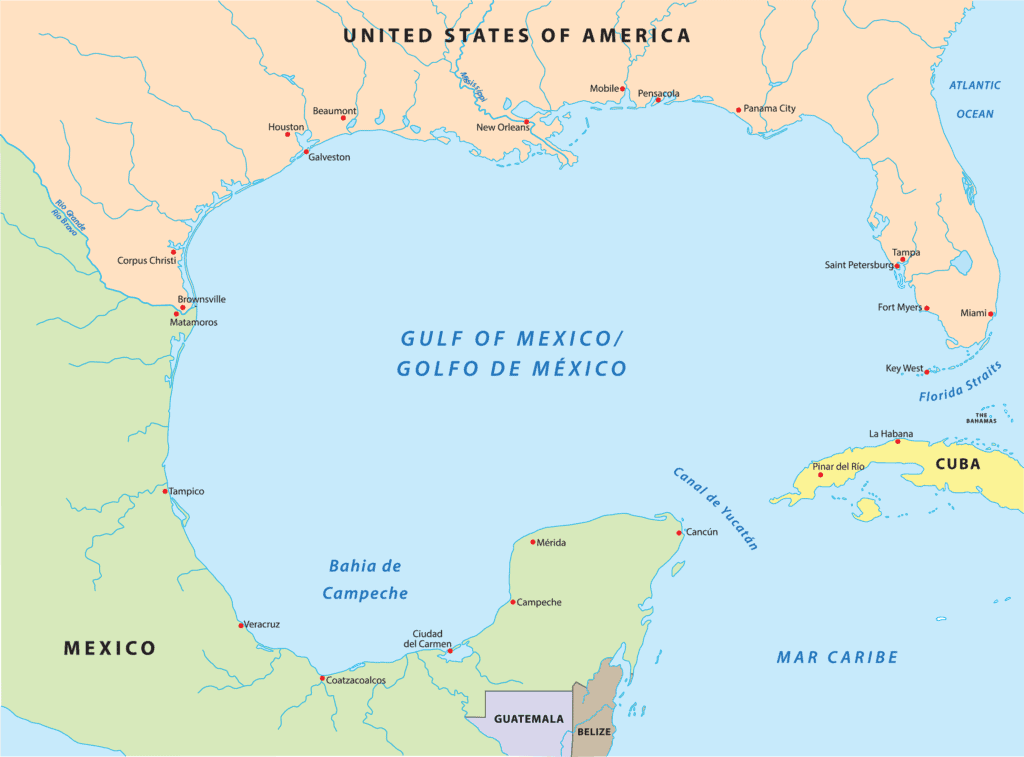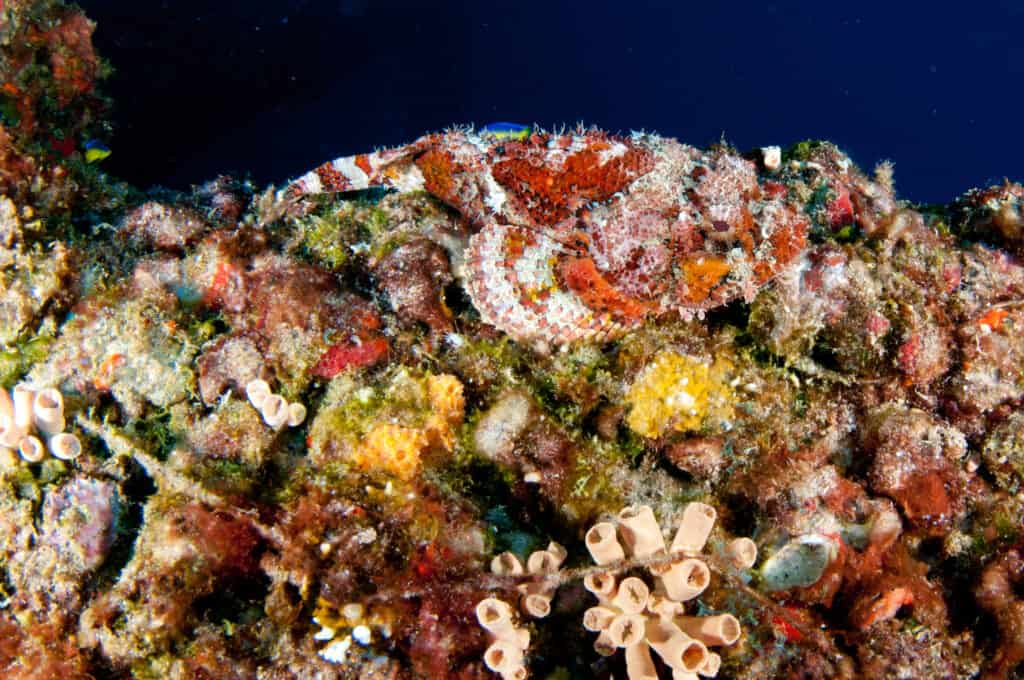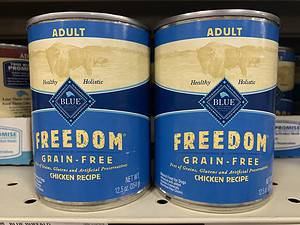The lowest point in Mississippi lies 370 miles due south of the Gulf of Mexico, and the city of Biloxi is a popular stop for travelers visiting the region. The Gulf is in the world’s top 10 most extensive bodies of water. It is a basin bounded by the Gulf Coast of the United States to the northeast, north, and northwest, and Mexico to the southwest and south.

The Gulf of Mexico is the ninth-largest body of water in the world and the lowest point in the state of Mississippi.
©Rainer Lesniewski/Shutterstock.com
What Is the Gulf of Mexico?
The Gulf of Mexico, or the Spanish Golfo de México, is a body of partly inland waters around southeastern North America. The Strait of Florida connects the Gulf of Mexico to the Atlantic Ocean. Both channels are about 100 miles wide. The Gulf’s maximum east-west and north-south extents are approximately 1,100 miles and 800 miles, respectively, covering an area of roughly 600,000 square miles. The Gulf of Mexico borders the southern coast of the United States to the northwest, north, and northeast and the eastern coast of Mexico to the west, south, and southeast. Sigsbee Deep is the Gulf of Mexico’s deepest point. This point is 17,070 feet below sea level in the Basin of Mexico. However, the Gulf of Mexico is unusually flat, with a slope of only about 1 foot per 8,000 feet.
Where Is the Gulf of Mexico Located on a Map?
Gulfport, a city on Mississippi’s Gulf Coast, lies 160 miles away from Jackson, the state capital. It can be reached following a 2-hour-47-minute drive via the US 49 S. The state’s second-largest city, it is an ideal location for watersports, festivals, historic neighborhoods, and even fans who intend to try their luck at placing wagers in casinos.
The Gulf of Mexico Has a Booming Tourist Industry
The coastal environment of the Gulf of Mexico supports a $19 billion wildlife tourism industry, with 20 million customers annually engaging in recreational fishing, hunting, and wildlife viewing. Wildlife tourism is a major economic driver in the Gulf States. Hundreds of tour guide companies compete to attract visitors. These tourists can stay at one of the thousands of vacation spots. From there, they can view this natural wildlife abundance.
The Climate at the Lowest Point in Mississippi
The Gulf of Mexico’s climate is tropical to subtropical in temperature. Seawater flows into the Gulf of Mexico via the Yucatan Canal. This water comes from the Caribbean Sea and circulates rapidly in a loop. After completing this loop, it exits the Gulf through the Strait of Florida and forms the Gulf Stream.
Abnormally high water temperatures in the Gulf often foster powerful Atlantic cyclones, causing widespread destruction. The Gulf’s hurricane season starts in early June and comes to an end in November. Between June and November, favorable conditions are created for hurricanes. Hurricanes form or enter the Gulf Coast and eventually land in the Gulf of Mexico area. Some of the strongest typhoons in the Gulf of Mexico were Hurricane Katrina, Hurricane Ike, Hurricane Harvey, Hurricane Michael, Hurricane Rita, and Hurricane Galveston.
Plant Life in the Gulf of Mexico – The Lowest Point in Mississippi
The Gulf of Mexico has a vast range of plant and animal species. It is widely known for its plant and animal diversity. These microbes vary from benthic organisms and meiofauna to other macro-organisms such as crabs, sea turtles, sea lilies, and other marine animals. Examples of aquatic plant life in the Gulf are seagrasses, mangroves, seaweeds, and marsh grasses.
Many fish, plankton, mussels, shrimp, manatees, and more sea creatures use these plants as their habitat. Upwelling processes near the coast of Florida Gulf bring cool, nutrient-rich water to the surface from the ocean’s depths. This upwelling encourages plankton growth, attracting large numbers of shrimp, small fish, and squid. Almost 500 species of shellfish live in the Gulf. The types of shellfish include oysters, clams, scallops, and clams.

Flower Garden Banks is a colorful
coral reef
with two marine reserves.
©Porco/Shutterstock.com
Flower Garden Banks is a colorful coral reef in the northwestern Gulf of Mexico. Two reefs on the Flower Garden Banks, the East Flower Garden Bank, and the West Flower Garden Bank, were named marine reserves in 1992. These reefs provide essential habitats for many marine animals like sharks, sea turtles, and rays. The Gulf of Mexico also has many mangrove forests and coastal wetlands.
Sealife in the Gulf of Mexico
The Gulf of Mexico supports a vast fish population. Important fish include albacore, red snapper, amberjack, grouper, tarpon, king mackerel, Atlantic spadefish, gulf flounder, and bluefish. Besides these smaller fish, roughly 25 shark species live in the Gulf of Mexico. Some of the most famous species are blacktip reef sharks, crowned reef sharks, bull sharks, hammerhead sharks, lemon sharks, nurse sharks, and sand tiger sharks. Additionally, about 33 species of whales live in the Gulf of Mexico. The most notable are the blue, Bryde’s, fin, orca, minke, humpback, sperm, and right whales. The Bryde’s whale was recently designated as an endemic species.
Diverse types of jellyfish also live in the waters of the Gulf of Mexico. Examples are the Southern Moon Jelly, Mushroom Jelly, Cannon Ball Jellyfish, Upside Down Jelly, and Portuguese Man of War. Some dolphins also live in this Gulf, like the Atlantic Spotted Dolphins, Striped Dolphins, Fraser’s Dolphins, Pantropical Spotted Dolphins, Clime’s Dolphins, and Spinner Dolphins.
The Gulf of Mexico is an essential habitat, nursery grounds, and feeding area for the area’s five endangered species of sea turtles. These include Kemp’s ridleys, loggerhead turtles, green turtles, leatherback turtles, and hawksbill turtles. Small turtle juveniles depend on open ocean sargassum habitats for survival. The Gulf of Mexico coast is a critical habitat for various coastal and waterfowl. With abundant wildlife, it is little wonder that the lowest point in Mississippi attracts so many tourists throughout the year.

The Portuguese
Man of War is a jellyfish
that lives in the Gulf of Mexico. These jellyfish are also known as blue bottles.
©NFKenyon/Shutterstock.com
The Lowest Point in Mississippi Has Many Shipwrecks
The Gulf of Mexico is a popular destination to visit because of its many sunken ships. This tourist attraction boasts approximately 4,000 shipwrecks, old and new. 750 of these have a trackable location. One of the oldest shipwrecks, believed to be around 200 years old, was discovered 4,000 feet below the surface of the Gulf. Luckily, many of the discovered wrecks are above the North American Continental Shelf, making them accessible.
The Lowest Point in Mississippi Was Once a Mountain Range
Before the Gulf of Mexico became what we know it to be today, it was a mountain range from Mexico to Alabama. In the Late Triassic age, 300 million years ago, Pangea shifted, creating the Gulf of Mexico. The Gulf of Mexico deepened and widened over the following 150 million years as the Earth moved. The Gulf of Mexico connects Mexico and the United States to the sea and is the marginal sea of the Atlantic Ocean. Almost half of the basin is shallow waters of the continental shelf. It is remote from the Atlantic Ocean, so tidal variations are minimal.
The Gulf of Mexico Features Many Oil and Petroleum Rigs
The Gulf Coast is home to several oil rigs that produce over 17% of all U.S. crude oil production. Experts estimate that more than 450 barrels of oil were produced in 2012, quickly surpassing 500 million barrels in two years. Projected oil production is now about 700 million barrels per year. The Office of Marine Energy Management, Regulation, and Enforcement in the United States is responsible for this progress.
The photo featured at the top of this post is © Anton Balazh/Shutterstock.com
Sources
- USGS, Available here: https://pubs.usgs.gov/gip/Elevations-Distances/elvadist.html
- Britannica, Available here: https://www.britannica.com/place/Gulf-of-Mexico
- Planeta, Available here: https://www.planeta.com/gulf-of-mexico/
- World Atlas, Available here: https://www.worldatlas.com/gulfs/gulf-of-mexico.html
- Ocean Explorer, Available here: https://oceanexplorer.noaa.gov/okeanos/explorations/ex1803/background/shipwrecks/welcome.html
- Marine Insight, Available here: https://www.marineinsight.com/know-more/10-gulf-of-mexico-facts-you-must-know/
FAQs (Frequently Asked Questions)
What is the lowest point in Mississippi?
The lowest point in Mississippi lies 370 miles due south of the Gulf of Mexico, and the city of Biloxi is a popular stop for travelers visiting the region. The Gulf is in the world’s top 10 most extensive bodies of water. It is a basin bounded by the Gulf Coast of the United States to the northeast, north, and northwest, and Mexico to the southwest and south.
What is the Gulf of Mexico?
The Gulf of Mexico, or the Spanish Golfo de México, is a body of partly inland waters around southeastern North America. The Strait of Florida connects the Gulf of Mexico to the Atlantic Ocean. Both channels are about 100 miles wide.
Thank you for reading! Have some feedback for us? Contact the AZ Animals editorial team.







